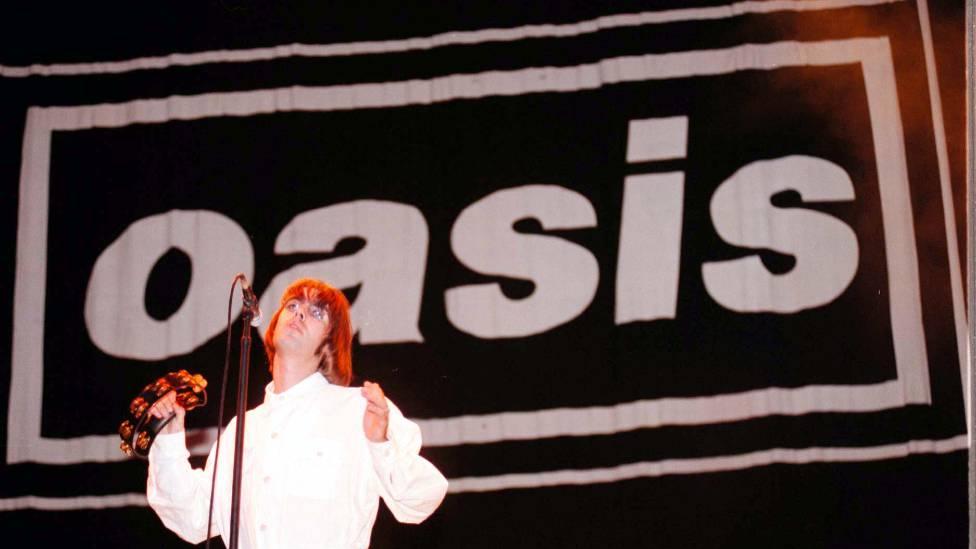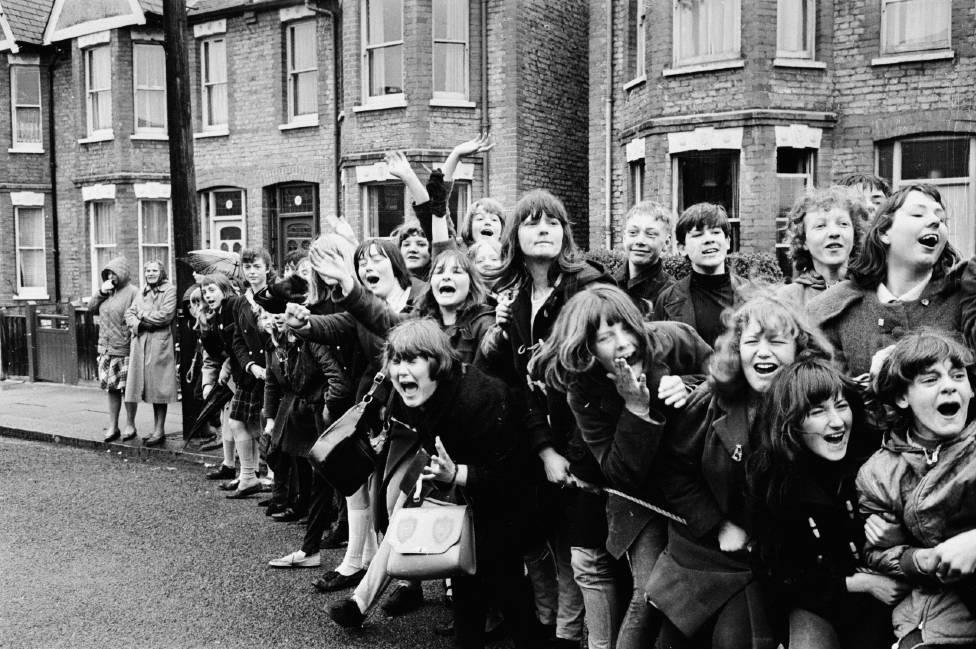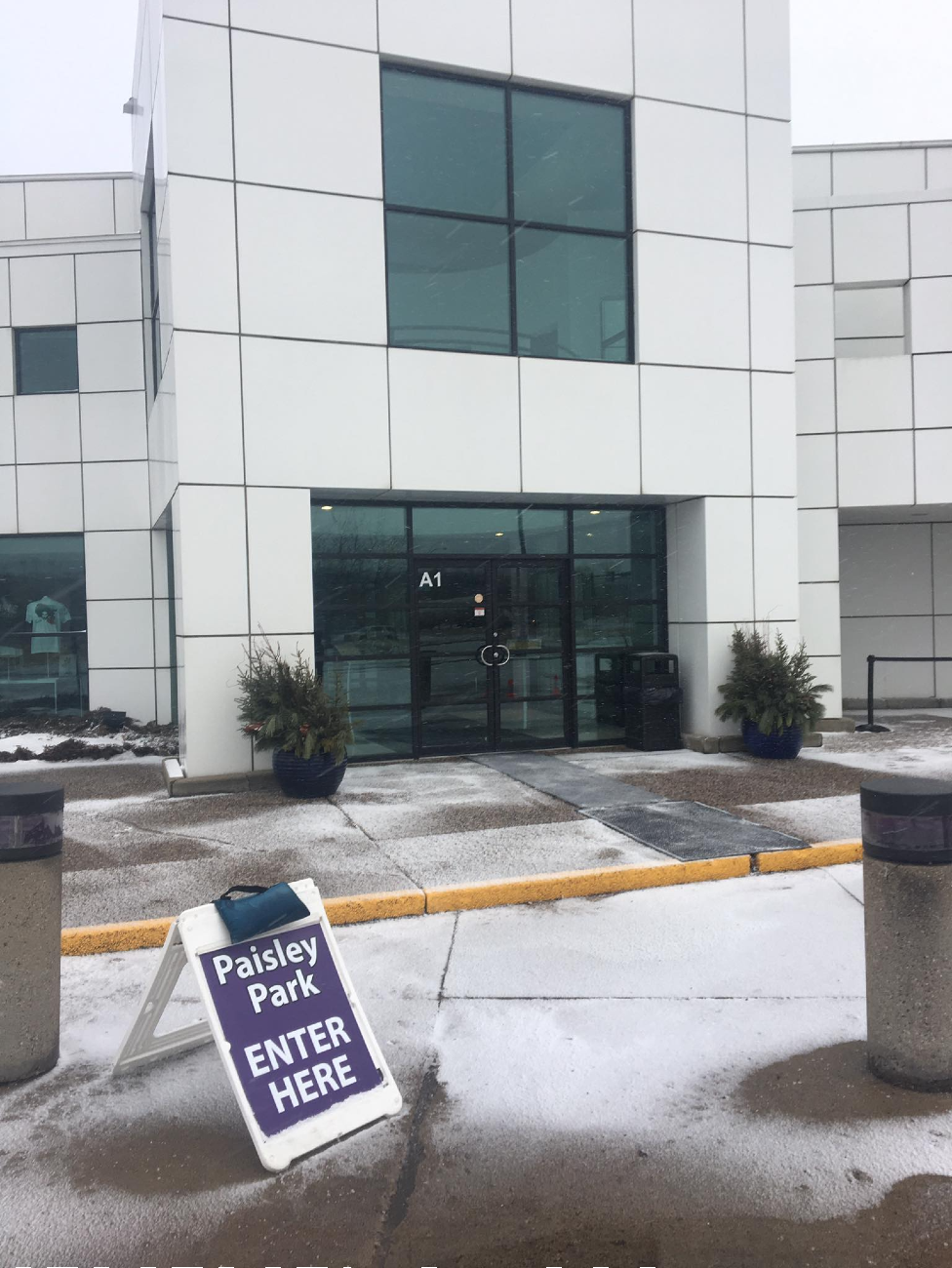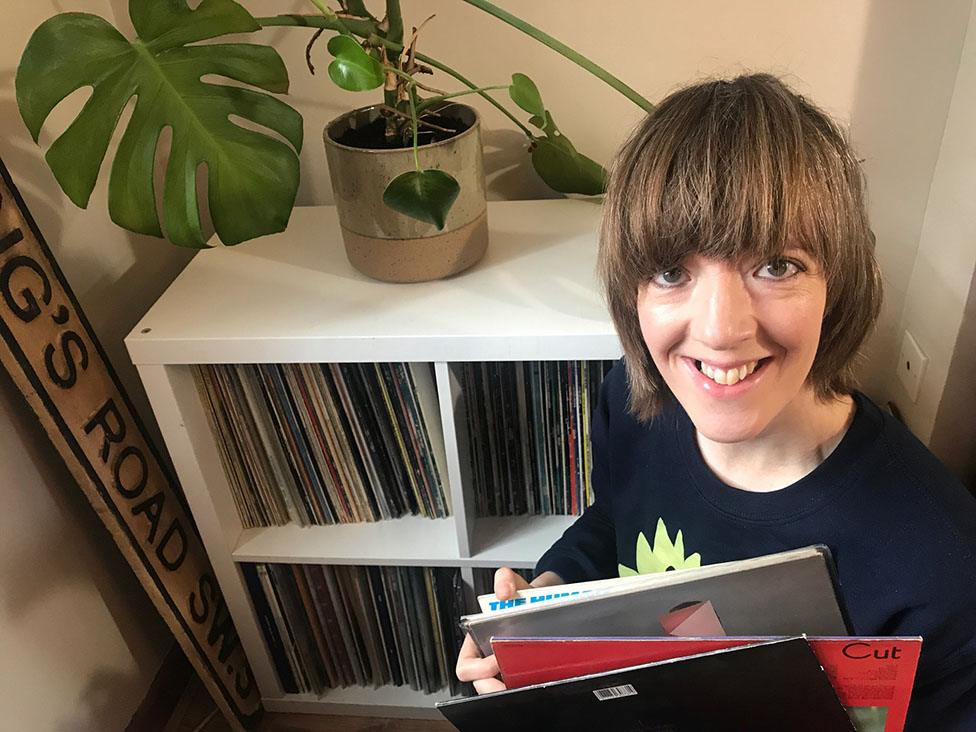Back to the mosh pit: What it means for super-fans
- Published

Live music is back - and for the most committed fans it's the return of an entire way of life.
That's me in the fourth row. I'm craning my neck and grinning in the polka-dot sea of faces. We fit into a neat square: a dense slice of human across the middle third. Above us the lighting rig. Below us the space up to the barrier, the edge of the stage, amplifiers and the outer reaches of a drumkit. The photo is a sandwich, and we are the filling. Our eyes are on the singer, but the singer is looking at us.
It's Courtney Barnett playing London's Electric Ballroom. She stops mid-gig to put us in the frame and later posts the photo on Instagram. And there I am. Just another face in the crowd, a music fan caught in the moment. It feels as if it's just happened: a snapshot from a regular gig in a regular venue on a regular night.
But looking at it now, what did Courtney know? "If you can't see me, I can't see you," she sings. The lyric is borrowed from a safety slogan used by truckers, but I think she's saying something else, to us in the crowd; to the viewer viewing her viewing us.

Courtney Barnett on tour
For a while, Barnett took a photo of her audience nearly every night. She did it in Melbourne, her home city, in Montreal, Oslo, Chicago, New York and in London. There we are, the fans, again and again, glued together on sticky floors, arms aloft, smiling. We are strangers, randomly assembled, but at that moment close. It's a closeness that can take us to the edge of something like euphoria. And it's a feeling impossible to recreate through a screen. Being there, it takes you somewhere else.

"All the people, so many people, and we allll go hand in hand..."
Liam Gallagher is singing an ironic excerpt from Blur's Parklife as he walks on stage at Knebworth. He's staring at a crowd of more than 125,000 fans. We are "all the people" and there could have been so many more of us.
As legend has it, 4% of the British population tried to buy tickets when Oasis played the grounds of a country house in Hertfordshire, 25 years ago. Around 250,000 people got to see the spectacle across that hot weekend in August 1996 and one of them was me, in a Blur T-shirt. I remember smiling to myself as, even in their most dominant hour, the Gallagher brothers and I both had their arch-rivals in mind.

Liam Gallagher began his Knebworth set with a sarcastic version of Blur's Parklife
I get my ticket thanks to my history teacher's son who has a spare. I know I'm not Andy's first choice companion but my well-advertised passion for music is enough to secure a place on the trip down from Yorkshire. I want to experience a mega gig for myself and it's the first truly massive concert of my life.
The sheer scale of Knebworth is ridiculous. Hundreds of coaches queue back-to-back: tens of thousands of us cram together in hushed awe as we first glimpse the giant stage. We are over excited, overwhelmed. Supernova Radio, a specially created Oasis-only radio station, booms out as we walk in. I am in enemy territory and wide eyed. Adventures like these teach you something about yourself and your tribe, especially when it's not quite your tribe. I am an observer.
The event feels like Spike Island, the legendary 1990 Stone Roses gig, but for my generation. There's a slight chaos in the air, a feeling that anything could happen and probably will: Liam and Noel casually riding through the noodle-eating masses on a golf buggy. Liam singing everything way too fast. Wonderwall, over and out in two minutes. Mass singalongs, people flailing on top of shoulders, beer sploshing expensively into the yellow grass. And then the Crystal Maze quest to find our coach again: a crazed, stumbling affair soaked in exhaust fumes and lager.

"All the people..." Knebworth in 1996 was one of the biggest concerts ever held in the UK
With sprawling music events like these, a sense of jeopardy is the key ingredient. Losing your friends at twilight, dancing in a swamp, a crowd surfer's lonely shoe. But through it all, we learn underrated life skills. Diplomacy with drunk people. Portaloo choices. Navigation techniques involving a burger van and a flag.
I often joke with my older sister about our first Glastonbury, a muddy one in the late-90s, and how it might have been a military boot camp disguised as entertainment. Liquid mud slops into my wellies with every pogo jump. But I'm devoted to the cause, it's too late to turn back. Our tent is the only survivor in a field that is now a lake floating with sleeping mats, cups and toothbrushes.
Claire dutifully spends each night "catching" people through the nylon as I try to sleep. The sound of rain and mud slapping against our fragile dwelling still haunts my dreams. But these are the pleasures - and horrors - that a live video stream from Worthy Farm cannot put you through. It's difficult and it's scary and it's very exciting.
To be a fan is often described as an obsessive thing, a bit unhealthy. Those types who think they are destiny-bound to befriend their idols. The people who hang around on doorsteps. Fans who sob on YouTube. For most, though, it's about private passions, the thrill of the chase, the joy of collecting, connecting and a sense of belonging to a tribe. It's about knowing everything about the thing you love and wearing that as a badge, but it's also about creating little habits and structures that enhance the everyday.

Beatlemania in 1965
In her book, Fangirls, Hannah Ewens meets and defends the Directioners (One Direction fans) portrayed as "crazy animals" in a 2013 Channel 4 documentary. The girls scream, cry and apparently "hunt" members of the band. Ewens takes things up with fan studies lecturer William Proctor, from Bournemouth University, who concludes that these young women are "no more dangerous, hyper-emotional, sexual or anything else than those who were part of Beatlemania or Frank Sinatra fandom".
The closest I've come to Beatlemania is screaming at Blur in Sheffield Arena, aged 16. Just as in the 60s, the air is thick with ecstatic white noise. We can see the band, but we can only hear ourselves. A shared primal scream: a feeling like no other.

Before the pandemic, Pat Jackson from Winnipeg, Canada, travelled the world with her daughter to see Blur and their many side projects. There's far less screaming now the band are middle-aged, but Pat is no less emotional. "When I discovered their music it reset the story of my entire life, really," Pat explains. "A band saved my life, and they truly did. I got out of a relationship, got a better career, found a better place to live with my daughter."
The desire to follow Blur meant Pat got her first passport and embarked on gig-fuelled adventures to London and New York. "It was a year of complete madness and I would not trade it for anything... especially after these past 17 months of global fear and anxiety, I am so utterly thankful that we did it all."

Pat Jackson's tattoo borrows the lyrics from the Blur song, Battle
It's through the Blur fan group on Facebook that we and many others share news, photos, video clips and memories on a daily basis. One kindly fan even sends me her spare "Food processors are great!" T-shirt. The internet, it's not all trolls and scammers. "Over the course of the pandemic we've spent many hours in Zoom listening parties, sharing our passion for the music and the band with fellow fans and developing wonderful friendships," says Pat.
I meet Bryan Robison from Indianapolis, US, in another band group, this time for fans of Stereolab. They make French-accented noise pop and their humorous, semi-political song titles create the perfect conditions for a smart, active community. We chat about the year without live music and what we have missed the most.
"It's that sense when you're at a gig and the familiar song starts. You look around and you can see the excitement. The audience moves in that mass and you can kind of feel it." He says music fandom is "part of my identity forever". "I live for going to shows. I love to go to concerts and I love a good small club show where you're packed in like a sardine."
"There are few things in life that can apply to any situation," he adds. "There's music that you go to when you're happy and there's music you go to when you're sad - and [everything] in between. You look for an escape, even if it's just for a few minutes, and you can find that with music."

Bryan shows off his "Cliff" tattoo - which makes him royalty among Stereolab fans
This sense of release has been absent for musicians as well as fans, and perhaps more acutely. "There are so many artists out there who live for the stage, who live for that interaction with the audience. I think even Morrissey's been missing taking it out on his fans," Bryan says with a grin. "That's so much of his identity."
During 18 months without gigs, performers found new ways to keep fans close.
Jarvis Cocker got out his fairy lights and invited us to a series of home DJ sets on Instagram. Twitter listening parties hosted by Tim Burgess connected music lovers directly with the artists behind legendary albums. Charli XCX Zoomed with her fans and asked them for help with her album art. Courtney Barnett got followers to film the view from their windows and turned them into a music video. And who can deny the joy of Sophie Ellis-Bextor's kitchen discos? As she stepped over children and Lego bricks in a leotard, we truly admired her spirit of glamour against all odds.
The pandemic has shown us the audience is more than the onlooker. Artists cannot truly operate without their fandoms. Fans can still congregate online while we wait for their return. But it's near impossible to replace that feeling of real-world tribal connections. Fellow '90s indie fan Charlie Ivens puts it perfectly: "It's an incredibly empowering feeling to know you can walk into a strange room and know at a glance the one person you might be able to have a decent chat with, just because of the T-shirt or badge they're wearing or their haircut or their shoes."

The singer from the support band has just lit my cigarette, without me asking. He's cute and he's confident and he sparks up my Marlboro Light as he sashays by. I am leaning against a wall, trying to act cool.
I smile and take an awkward puff. He's now on his way back from the bar and heading over. He wants to talk about music. New Order, Joy Division and The Smiths. He's surprised I know them. I explain these groups are the cornerstones of English alternative music and probably one of the reasons I'm at his gig. "But girls where I'm from, they don't know this stuff," he says. I feel a rush of defensiveness toward the female music fans of Vegas, and tell him so.
And then Brandon Flowers, front man of little-known act The Killers, gives me his button badge, smiles and wanders off into a glittering career of Glastonbury headline sets, magazine covers, MTV and Brit Awards. I stub out my cigarette. It's 2003 and I don't know it, yet, but I've got one of those stories now, the kind of story I'll be retelling in 18 years.

Brandon Flowers performs with The Killers
When my daughter is three, gig serendipity strikes again. I'm at a fundraising night for a children's nursery in an old Victorian community hall on the edge of a south London park. Long tables are set with coloured paper napkins. Streamers criss-cross overhead. I notice the stage is being prepared for an unadvertised performance. Red origami pom-poms hang suspended as a microphone stand is adjusted. And then it happens: Laetitia from Stereolab is playing tonight, here.
Her son went to the nursery so the room is split between people who know her, so aren't gobsmacked, and people who have no idea who Stereolab are, so aren't gobsmacked. And then there's me in between: mouth open-wide, completely, delightedly gobsmacked.
It's a beautiful performance and the perfect example of the luck in live music. I could easily have stayed in that night. That's what we do, isn't it? We stay in and we miss the chance for a chance happening.

Laetitia from Stereolab's secret gig at a children's nursery
A while later I am at All Tomorrow's Parties, a music festival held at Pontin's at Camber Sands on the English south coast, and a gathering famed for its rock 'n' roll sightings. Jarvis Cocker buying custard creams in Nisa. Kim Gordon from Sonic Youth playing air hockey. Laetitia Sadier is playing a solo set and so I queue up afterwards to get my LP signed. She writes her name in humble Biro and as she does so, I sense the opportunity to tell her "I was there" back at the nursery, the secret gig of the year. She looks up, slightly startled, as if I've rumbled her other life. And then she chuckles.

"A taxi to Chanhassen, please..." We know it's serious because the car pulls up with chains on its wheels. A softly spoken man nods and gestures us inside, the biting cold swooshing across the smooth black leather seats. I pull in the skirts of my cold weather parka and slam the door. The mechanism thuds shut. Things here actually sound cold.
My companion is wearing a fur hat. I am in ski gloves. We look at each other nervously, still tasting the snow. A squall of pure white fills the windscreen. "Don't travel unless your journey is essential," is a familiar winter phrase in the UK. But we are in Minnesota, US, and we have an appointment at Paisley Park.
It is February 2017 and not yet a year since the death of music icon, Prince. His legendary compound has the industrial air of an out-of-town warehouse. There is no real hint of what lies within. White doves flit about in the atrium as we gather with a cluster of super-fans for the start of a guided tour. Our phones have been locked away to prevent covert photos. The whole thing feels like a dream, but at the core of Paisley Park is an unbelievable surprise.

A visit to Paisley Park in the snow
As we round a corridor from multiple recording studios, we see it. It is just shockingly huge, like an aircraft hangar. This is where Prince played his famed last-minute, invite-only gigs: a truly vast and completely empty concert venue. I look upwards to the far-away metallic rafters, up-lit in shades of purple. This crazy space, big enough for a jet, leads to the "NPG club" (New Power Generation, Prince's band) - an actual nightclub space with sofas, tables, a smaller stage, and a giant neon Prince symbol overhead. The guide tells us stories of Prince playing here at post-gig gigs which lasted until daybreak. He once "serenaded Madonna here for two hours straight".
"Paisley Park is a wonderful place, a testament to creativity and hard work. It's humbling, inspiring and cathartic all at the same time," Casey Rain tells me over Zoom. He's a Prince super-fan from Birmingham, UK, who runs the most successful Prince channel on YouTube. He tells me about the time he met his idol. "I felt his aura, like a visible bright, warm glow. It's hard to explain, but those who know, know. He had a way of appearing almost out of nowhere and then disappearing the same way."

Yours truly, in the mosh pit
Anyone who ever saw Prince live, or has watched him on YouTube, will know he was born to perform, perhaps the supreme performer of the last half century. His home, now a recording space and museum, may be a place designed for people, but my memory is of echoing emptiness. The star is gone but the fans still stare at the stage. That's me, still staring. But as music venues finally roll up the shutters and festival turnstiles click open again, it's all of us. We are the space. Our bodies are the event. And if the singer can't see us, we can't see them.
See you down the front?
Follow @annadoble, external on Twitter
You may also be interested in...

Nearly a year since the start of the first UK lockdown, I've listened to every LP I've ever bought - and found a diary of my life in the grooves.
'I've been listening to 300 vinyl records to get me through lockdown'